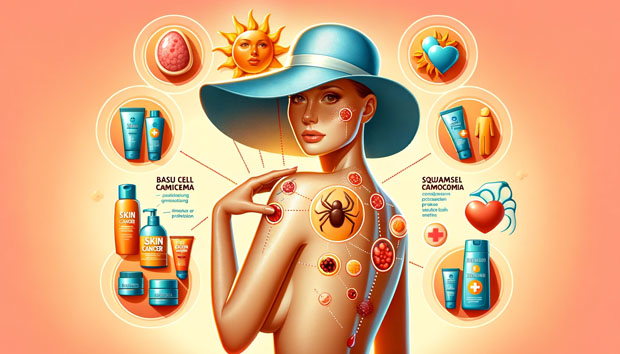According to the American Cancer Society, skin cancer is the most common type of cancer.
Most skin cancers are preventable.
Three main types of skin cancer :
- Basal cell carcinoma: Basal cell carcinoma begins to develop in basal cells, a type of skin cell that produces new skin cells when old ones die off. Basal cell carcinoma often manifests as a skin change, such as a growth or ulcer that does not heal or manifests as a slightly transparent lump on the skin.
- Squamous cell carcinoma: this is a common form of skin cancer that develops in the squamous cells that make up the middle and outer layers of the skin. Signs and symptoms of squamous cell skin cancer include the appearance of a hard red node, a flat ulcer with a scaly crust, and the development of an inflamed or raised area above an old scar or ulcer.
- Melanoma — accounts for only about 1% of skin cancers, but it is the cause of most skin cancer deaths, according to the American Cancer Society. Melanomas develop in cells that produce melanin, the pigment that gives the skin its color. The first sign of melanoma is often a mole that changes size, shape, or color. The eyes also contain melanin-producing cells and melanomas can develop. Ocular melanoma is most often formed in the part of the eye that cannot be seen when looking in the mirror, which makes it difficult to detect.
Skin cancer mainly develops in areas that are more exposed to the sun, including the scalp, face, lips, ears, neck, chest, arms, and legs.
Skin cancer can also form in areas rarely exposed to daylight, including palms and soles, areas under the nails of the hands or feet, and the genital area.
Skin cancer affects people with any skin color, including those with darker skin.
However, the presence of a smaller amount of pigment in the skin provides less protection from harmful ultraviolet radiation.
People with light or red hair and light eyes, who easily develop freckles and who are easier to burn in the sun, are much more likely to develop skin cancer than people with darker skin.
You can reduce your risk of developing skin cancer by limiting or avoiding exposure to ultraviolet or UV radiation by following these steps:
- expose to sunlight during the midday hours;
- Regular year-round use of sunscreen;
- Wearing appropriate clothing;
- It is recommended to avoid tanning salons;
- Increased attention to skin care when using drugs that cause increased sensitivity to sunlight


Leave a Reply